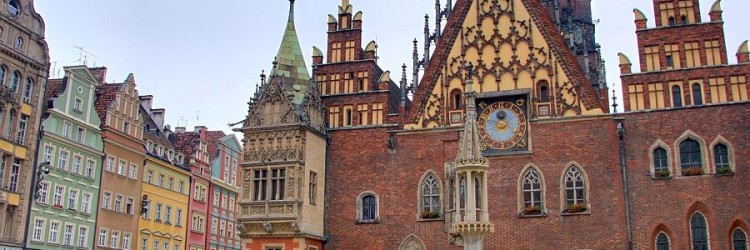Wrocław European Capital of Culture Venice of the North
Wrocław ( German: Breslau), the largest city in western Poland and without a doubt one of the most beautiful in Europe, has become the European Capital of Culture 2016. Around 1,000 cultural events will draw tourists to this open, friendly and exciting city. This year the slogan "Wrocław - The Meeting Place" is more acurate than ever.
Wrocław is one of the oldest cities in Poland. At various times in history, it has been part of the Kingdom of Poland, Bohemia, Hungary, the Austrian Empire, Prussia, and Germany. The mixture of many different religions and cultures, whilst troublesome at times, has also contributed greatly to the city. Wrocław lies in the middle of the Silesian Lowlands, where the River Odra branches out forming 12 islands. More than 100 bridges span the city and seen from the deck of a tour boat, Wroclaw looks like a city built on water. That’s why Wrocław is also called the Venice of the North. A huge surprise for many tourists is the presence of plenty of dwarf’s monuments – one of Wroclaw’s symbols. You can find over 300 of them spread all over the city.
Wrocław has firmly established itself among Prague and Kraków as one of Eastern Europe’s top tourist destinations and one of the undisputed highlights of Poland. Norman Davies, an outstanding researcher of European history, has hailed the city “a flower of Europe”. There are two essential areas that visitors shouldn’t allow themselves to miss. The first is obviously the Old Town, with the marvellously restored Market Square and its maze of cobbled streets, canals, bridges and church spires. The second is Ostrów Tumski, known as the ‘Cathedral Island’. It was the first part of Wrocław to be settled by Slavic tribes in the 9th century. Since then it has remained an important place of royal and religious significance, and home to the city’s most important Cathedral.
As the 2016 European Capital of Culture, Wrocław has prepared 12 adventurous weekends of culture for visitors from Poland and abroad. Each weekend will comprise interdisciplinary events intended for the general audience. The actions are arranged in a way that will make it possible to immerse in culture and art for the whole day – from visiting galleries and participating in concerts and spectacles to having fun during animated workshops. The visitors can choose their own unique paths by selecting the most interesting events from the rich cultural programme. The European Film Awards, the Theatre Olympiad, and a meeting of European choirs – these are just a few of the artistic events to be held in Wrocław whilst the city holds the title of European Capital of Culture.
Visiting Poland can be a very rewarding experience, especially if you extend your visit to other parts of the country. In July 2016 Kraków will host The World Youth Day, giving you one more reason to visit Poland this year. If you are looking nature or for less-known attractions, Eastern Poland wil surely satisfy your needs. You will be surprised by beauty of cities like Zamość, Lublin or Białystok, all easily reached by train or bus from Warsaw. Meeting with European bison, the largest land mammal of the Old Continent in famous Białowieża Forest will stay in your memory forever. So will the meeting with elk – the king of the Biebrza Marshes. You could rent a kayak and discover the Biebrza Marshes, traversing the endless space of the wild Biebrza River. Another highlight of your trip could be kayaking and birdwatching on the Narew, one of Europe’s few braided rivers. It’s called “the Polish Amazon” for a rerason! (See more info: Meet the Nature).
If you need more reasons to visit Eastern Poland, think about your money. Prices of food, acommodation and excursions are much cheaper than in Western Europe. Come and take advantage when it lasts!

Leave a Reply